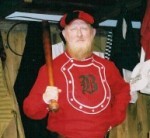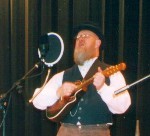Living History Characters Available (In Chronological Order)
In the Steps of a Peacekeeper (Conrad Weiser, 1696-1760)
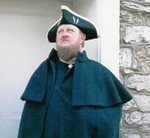 To know Conrad Weiser is to know his adopted Mohawk name (tarachiawagon: the man who held up the sky). Born in Astat, Wurtenberg, November 2, 1696, this unsung Pennsylvania hero epitomizes life on the American frontier from 1710 until his death in 1760. During that time – he was a statesman, diplomat, traveler, judge, linquist, Lieutenant Colonel, farmer and official Pennsylvania peacekeeper.
To know Conrad Weiser is to know his adopted Mohawk name (tarachiawagon: the man who held up the sky). Born in Astat, Wurtenberg, November 2, 1696, this unsung Pennsylvania hero epitomizes life on the American frontier from 1710 until his death in 1760. During that time – he was a statesman, diplomat, traveler, judge, linquist, Lieutenant Colonel, farmer and official Pennsylvania peacekeeper.
The Spirit of the West, Born in Pennsylvania (“Stoffel” Stump, 1750’s Pioneer)
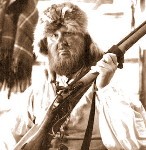 Let the spirit of Palatine immigrant Stoffel Stump lead you on a journey through the accomplishments of two of Pennsylvania’s most famous 18th century pioneers, Conrad Weiser and Daniel Boone–both instrumental in molding the Spirit of Westward Expansion.
Let the spirit of Palatine immigrant Stoffel Stump lead you on a journey through the accomplishments of two of Pennsylvania’s most famous 18th century pioneers, Conrad Weiser and Daniel Boone–both instrumental in molding the Spirit of Westward Expansion.
Trekking the Pike in 1809 (John Jacob Keplinger, 1809 Wagoner)
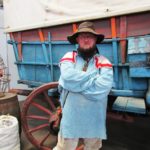 Experience the language, customs, songs and stories of the legendary Conestoga wagoners. Journeying at the amazing speed of two miles an hour, join John Jacob Keplinger of Lancaster County (PA) as he travels on the original “turnpikes” that linked the east coast with America’s interior.
Experience the language, customs, songs and stories of the legendary Conestoga wagoners. Journeying at the amazing speed of two miles an hour, join John Jacob Keplinger of Lancaster County (PA) as he travels on the original “turnpikes” that linked the east coast with America’s interior.
Veins of Iron (Issachar Pawling, 1836 Ironworker)
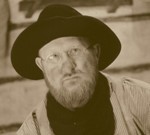 With an opinion on many topics, Issachar Pawling weaves stories and songs of life at an 1836 charcoal iron plantation with national trends. Hear of canal and railroad construction, labor unrest, and new ironmaking technologies that threaten to totally change the “old way” of life he knows.
With an opinion on many topics, Issachar Pawling weaves stories and songs of life at an 1836 charcoal iron plantation with national trends. Hear of canal and railroad construction, labor unrest, and new ironmaking technologies that threaten to totally change the “old way” of life he knows.
Ironman, Go West (Jack Adair, 1859 Blacksmith/Oregon Trail Emigrant)
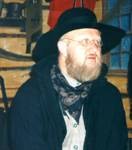 Find Jack Adair, a blacksmith and former Pennsylvania ironworker, on the streets of St. Louis as he gathers a crowd to talk about answering the call to “Go West” on the Oregon Trail. Hear stories of cholera, alkali water, breakdowns and feuds among those following the cry of “manifest destiny”.
Find Jack Adair, a blacksmith and former Pennsylvania ironworker, on the streets of St. Louis as he gathers a crowd to talk about answering the call to “Go West” on the Oregon Trail. Hear stories of cholera, alkali water, breakdowns and feuds among those following the cry of “manifest destiny”.
The Core of the War (Mahlon “Muley” Tubbs, Civil War Supply Train Wagon Boss)
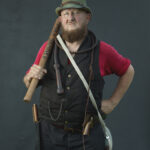
This portrayal of a contracted civilian boss of a 25-wagon supply train interprets the vital, but often disregarded, role of supplying the armies (both Union and Confederate) during the American Civil War. Dressed in authentic clothing of the period, “Muley” is complete with horse and mule smells, manure-covered boots, a mud-stained slouch hat, and the attitude of a bald-headed full-bearded man who gets along better with horses and mules than colonels and generals. Depending on the venue, “Muley” Tubbs can come to your event or site with a detailed compact three-panel exhibit which includes photographs and information on the muleskinners, wagon types, the value that horses and mules provided during the Civil War, the pain/frustration of working with mules and the life of an army mule and horse. Click for more information.
At the Ready! (Oliver Willcox Norton, 1862-1865 Civil War Bugler)
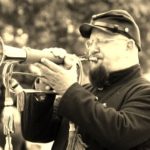 Re-live the Civil War through the eyes of Oliver Willcox Norton, the bugler credited with playing a instrumental role in the writing of what we now know as “Taps.” The bugler’s role was to announce the daily duties outlined for the infantry soldier in camp and on the battlefield. He became the mouthpiece of the Commanding Officer in Charge. The effectiveness of the bugler helped to determine the success of the unit on and off the field.
Re-live the Civil War through the eyes of Oliver Willcox Norton, the bugler credited with playing a instrumental role in the writing of what we now know as “Taps.” The bugler’s role was to announce the daily duties outlined for the infantry soldier in camp and on the battlefield. He became the mouthpiece of the Commanding Officer in Charge. The effectiveness of the bugler helped to determine the success of the unit on and off the field.
Created Equal… (Levi Bull Smith, 1863 Ironmaster & Abolitionist)
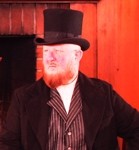 It is June 29, 1863 and you are part of a crowd gathered in Reading, Pennsylvania to hear a speech from Levi Bull Smith–ironmaster and abolitionist. Experience the story of the Civil War through a unique view. His speech, two days before the battle of Gettysburg, concentrates on the issues of slavery, the underground railroad, the Fugitive Slave Law, the 1851 Christiana Revolt, the Emancipation Proclamation, and the imminent invasion of the north by Confederate forces.
It is June 29, 1863 and you are part of a crowd gathered in Reading, Pennsylvania to hear a speech from Levi Bull Smith–ironmaster and abolitionist. Experience the story of the Civil War through a unique view. His speech, two days before the battle of Gettysburg, concentrates on the issues of slavery, the underground railroad, the Fugitive Slave Law, the 1851 Christiana Revolt, the Emancipation Proclamation, and the imminent invasion of the north by Confederate forces.
“Canawling” on America’s Canals (John Hummel, 1870’s Canal Captain)
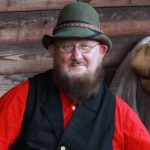 “Cappy” Hummel represents hundreds of fellow canalmen (Irish ditch diggers, towpath walkers, muletenders, locktenders, and boatmen) who built and traveled America’s canal systems. Hear the “sneckehorn” blow, and hear the songs from the past as “Cappy” takes you for an entertaining, action-packed trek on the canal.
“Cappy” Hummel represents hundreds of fellow canalmen (Irish ditch diggers, towpath walkers, muletenders, locktenders, and boatmen) who built and traveled America’s canal systems. Hear the “sneckehorn” blow, and hear the songs from the past as “Cappy” takes you for an entertaining, action-packed trek on the canal.
Buildin’ the Rails (Mike Malloy, 1880’s Railroad “Gandy Dancer”/Trackman)
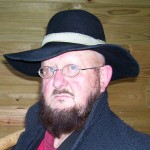 More than any other mode of transportation, the railroad epitomized American technological and commercial development. Through the tales and work songs of Irish “Gandy Dancer” Mike Malloy, learn of the contribution of the railroad to the peopling of America.
More than any other mode of transportation, the railroad epitomized American technological and commercial development. Through the tales and work songs of Irish “Gandy Dancer” Mike Malloy, learn of the contribution of the railroad to the peopling of America.
Shays, Peaveys and Wood Hicks: Early Logging Days (Jack Hains, 1890’s Logger)
 Join the spirit of 19th century “Wood Hick” Jack Hains as he tells of the pioneer, water transportation and logging railroad eras of the lumber industry. Learn about log slides, splash dams, Barnharts, Shays, “cookees”, knot bumpers, peaveys, cant hooks and the “natural law of succession” of the forest.
Join the spirit of 19th century “Wood Hick” Jack Hains as he tells of the pioneer, water transportation and logging railroad eras of the lumber industry. Learn about log slides, splash dams, Barnharts, Shays, “cookees”, knot bumpers, peaveys, cant hooks and the “natural law of succession” of the forest.
Oil Boom Days (Charles “Muley” Tubbs, Late 19th Century Oil Region Teamster)
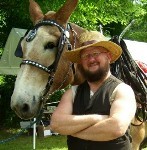 As the “eyes” of Pennsylvania’s Oil Region, the spirit of the past of colorful teamster Muley Tubbs tells the stories of the discovery of oil by the Seneca Indians, Colonel Drake and Uncle Billy Smith and then takes the audience through the “boom and bust” days of this northwestern PA industry.
As the “eyes” of Pennsylvania’s Oil Region, the spirit of the past of colorful teamster Muley Tubbs tells the stories of the discovery of oil by the Seneca Indians, Colonel Drake and Uncle Billy Smith and then takes the audience through the “boom and bust” days of this northwestern PA industry.
Fire in the Hole! (Frank Kehoe, 1905 Coal Miner)
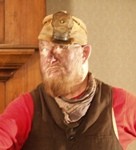 Coal was the fuel of America’s Industrial Revolution and no one knows the dangers of “life below ground” better than Irish miner, Frank Kehoe. Learn of life in the “patch”, the company store, the progression from breaker boy to “miner with papers”, the Mollie Maguires and the United Mine Workers Strike of 1902.
Coal was the fuel of America’s Industrial Revolution and no one knows the dangers of “life below ground” better than Irish miner, Frank Kehoe. Learn of life in the “patch”, the company store, the progression from breaker boy to “miner with papers”, the Mollie Maguires and the United Mine Workers Strike of 1902.
Legends of the Backwoods: From Market Hunter to Sportsman/Conservationist (Lamar “Bucky” Jones, 1906 Market Game Hunter)
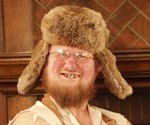 Through the eyes of lawless eastern market hunter Bucky Jones, see and hear about the scarcity of wildlife and habitat at the turn of the century and, out-of-character in the second scene of this two part program, hear about the successful evolution of wildlife conservation.
Through the eyes of lawless eastern market hunter Bucky Jones, see and hear about the scarcity of wildlife and habitat at the turn of the century and, out-of-character in the second scene of this two part program, hear about the successful evolution of wildlife conservation.
(This program can also be adapted to reflect market hunting in the West.)
Legends of the Back Bay: Waterfowling on the Chesapeake
(Willy Pawley, 1918 Chesapeake Bay Waterfowler)
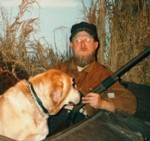 Join Spittin’ Willy Pawley as he talks of his livelihood in the days when punts guns and battery guns were legal tools of his trade. Learn of the changes of the past twenty years–as laws, game wardens, licenses and now the Migratory Bird Treaty Act have transformed him from family provider to outlaw (of sorts!).
Join Spittin’ Willy Pawley as he talks of his livelihood in the days when punts guns and battery guns were legal tools of his trade. Learn of the changes of the past twenty years–as laws, game wardens, licenses and now the Migratory Bird Treaty Act have transformed him from family provider to outlaw (of sorts!).
SPECIAL PROGRAMS
An Old-Fashioned Pennsylvania German Christmas
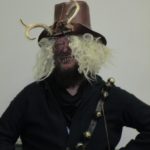
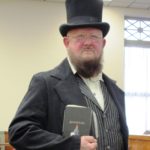 Through the stories of an 19th century schoolmaster, learn about the Christmas customs of the Pennsylvania Germans of the 1800’s. Then after a brief interlude, experience first-hand the Christmas Eve custom of Belsnickling as this mischievous hobgoblin of the forest inspects the people of the audience to determine who really has “been good this year”.
Through the stories of an 19th century schoolmaster, learn about the Christmas customs of the Pennsylvania Germans of the 1800’s. Then after a brief interlude, experience first-hand the Christmas Eve custom of Belsnickling as this mischievous hobgoblin of the forest inspects the people of the audience to determine who really has “been good this year”.
 To know Conrad Weiser is to know his adopted Mohawk name (tarachiawagon: the man who held up the sky). Born in Astat, Wurtenberg, November 2, 1696, this unsung Pennsylvania hero epitomizes life on the American frontier from 1710 until his death in 1760. During that time – he was a statesman, diplomat, traveler, judge, linquist, Lieutenant Colonel, farmer and official Pennsylvania peacekeeper.
To know Conrad Weiser is to know his adopted Mohawk name (tarachiawagon: the man who held up the sky). Born in Astat, Wurtenberg, November 2, 1696, this unsung Pennsylvania hero epitomizes life on the American frontier from 1710 until his death in 1760. During that time – he was a statesman, diplomat, traveler, judge, linquist, Lieutenant Colonel, farmer and official Pennsylvania peacekeeper.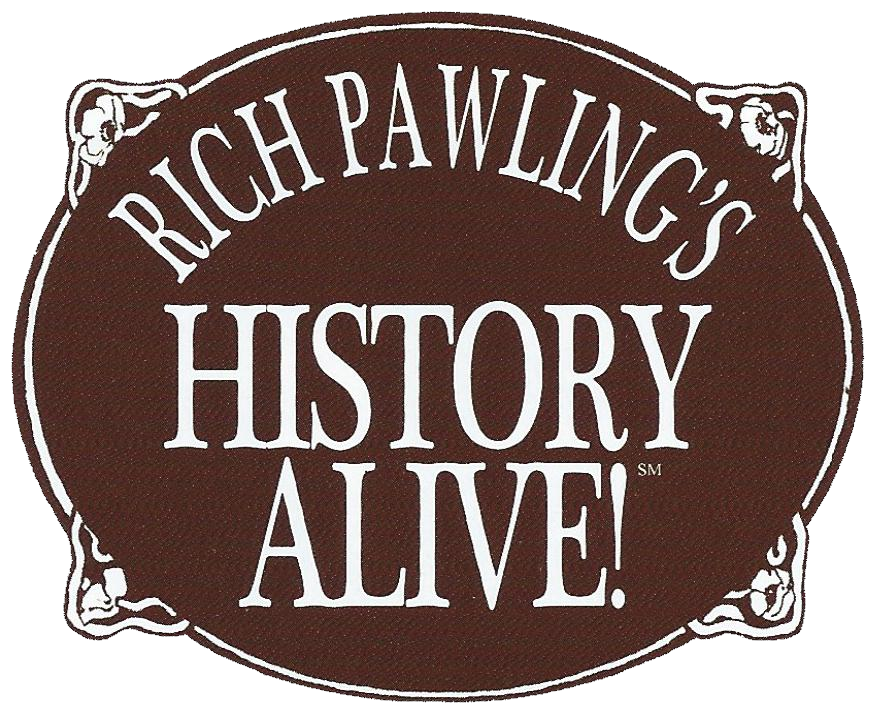

 Experience the language, customs, songs and stories of the legendary Conestoga wagoners. Journeying at the amazing speed of two miles an hour, join John Jacob Keplinger of Lancaster County (PA) as he travels on the original “turnpikes” that linked the east coast with America’s interior.
Experience the language, customs, songs and stories of the legendary Conestoga wagoners. Journeying at the amazing speed of two miles an hour, join John Jacob Keplinger of Lancaster County (PA) as he travels on the original “turnpikes” that linked the east coast with America’s interior.


 Re-live the Civil War through the eyes of Oliver Willcox Norton, the bugler credited with playing a instrumental role in the writing of what we now know as “Taps.” The bugler’s role was to announce the daily duties outlined for the infantry soldier in camp and on the battlefield. He became the mouthpiece of the Commanding Officer in Charge. The effectiveness of the bugler helped to determine the success of the unit on and off the field.
Re-live the Civil War through the eyes of Oliver Willcox Norton, the bugler credited with playing a instrumental role in the writing of what we now know as “Taps.” The bugler’s role was to announce the daily duties outlined for the infantry soldier in camp and on the battlefield. He became the mouthpiece of the Commanding Officer in Charge. The effectiveness of the bugler helped to determine the success of the unit on and off the field.
 “Cappy” Hummel represents hundreds of fellow canalmen (Irish ditch diggers, towpath walkers, muletenders, locktenders, and boatmen) who built and traveled America’s canal systems. Hear the “sneckehorn” blow, and hear the songs from the past as “Cappy” takes you for an entertaining, action-packed trek on the canal.
“Cappy” Hummel represents hundreds of fellow canalmen (Irish ditch diggers, towpath walkers, muletenders, locktenders, and boatmen) who built and traveled America’s canal systems. Hear the “sneckehorn” blow, and hear the songs from the past as “Cappy” takes you for an entertaining, action-packed trek on the canal.






 Through the stories of an 19th century schoolmaster, learn about the Christmas customs of the Pennsylvania Germans of the 1800’s. Then after a brief interlude, experience first-hand the Christmas Eve custom of
Through the stories of an 19th century schoolmaster, learn about the Christmas customs of the Pennsylvania Germans of the 1800’s. Then after a brief interlude, experience first-hand the Christmas Eve custom of 